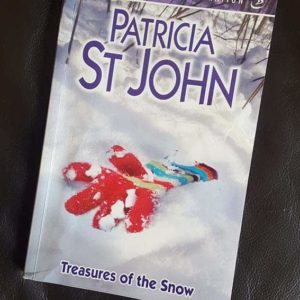
I’ve just finished reading Patricia St John’s Treasures of the Snow to my girls (ages 4 and 6). We started it when we were in the snowy Alps earlier in the year, as it seemed very seasonal, and we’ve only just finished it mainly due to business and that my 4yo is only just starting to enjoy chapter books. For me, it’s been an emotional read, with the combination of the memories of being read the story as a child and the emotional storyline (the mother dies in the first chapter, which I’d totally forgotten). My 6yo daughter got totally into the character development of the two main characters, and closely followed their emotional journey as the plot unfolded, feeling their pain, joy, anger and so on.
Some people might ask why we read Christian fiction with our children. I’d answer why not? We don’t read it instead of the Bible, but alongside. We don’t read exclusively Christian books, but read lots of non-Christian fiction, as well as non-fiction. Here’s some great things we got out of this book:
1 In the story, the children learn about God from their Grandmother. I love how this gives a picture of faith at home, faith being lived out and passed on through the generations. And multi-generations too.
2 In the story, the Grandma quotes some Bible verses and helps the children apply them into their situations, specifically about Jesus knocking at the door and about love chasing away fear. The children mull over these verses as they have obviously spoken to them, and use them to move forward in their journey with God. It’s written in a simple way a child could emulate and encouraged me to teach my children more Bible verses so they have a stock to use throughout their lives.
3 Something I loved about this book was the way it gave an example of what being a Christian child might be like. When my second daughter was due, we read books with my first about being a big sister. I see this as serving a similar purpose. It’s not The Way to Christian but A Way to be Christian. One of the families are Christians and it’s not a story about their faith, but a story about their lives in which their faith plays an increasingly vital part. This normalising Christian life is easy to do in fiction.
4 The book tackles issues of anger and forgiveness in a few different ways, letting the read feel the fury of injustice as well as the pain of unforgiveness. Both children in the story experience each side of this issue in different ways giving lots of opportunities to chat about ways in which we deal with forgiveness too.
5 The book feels safe. Even though it’s listed as for 7 to 10-year-olds, I’ve felt confident reading it with my 6 year old, knowing there won’t be any hidden *nasties* which I may have to edit.
You can get a copy of this book from Scripture Union including an e-book version
